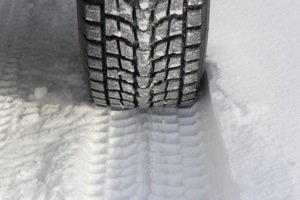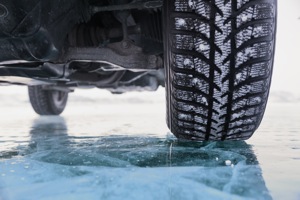You don’t have to live in Iceland to benefit from winter tires,” says Michelin North America’s Ron Margadonna. Yet North America apparently is the least likely continent to recognize that fact.
“North America is the only market in the world that has an all-season tire product,” explains Giti Tire USA’s David Shelton. “But all-season tires are a balance of properties, or a compromise that places the product’s capabilities between a dedicated summer-only tire and a true winter tire. With a compromise, one loses some of the benefits on the extremes in road conditions we encounter in different climates.
“A winter tire is engineered to be flexible and grip in extremely cold temperatures and is designed to handle the slush, ice and wet pavement,” adds Shelton, Giti’s director of marketing. “Only a dedicated winter tire will give the consumer the control and traction they need and expect in order to get them to and from their destination – to get them home safe when the weather outside is frightful.”
Exactly what, a North American consumer might ask, is frightful enough weather to warrant winter tires?
“It comes down to geography and temperature,” says Margadonna, MNA’s senior technical marketing manager. “If the temperature is consistently below 44˚F or 7˚C, tires need the extra grip that only winter tires can deliver. Even if consumers have four-wheel drive or all-wheel drive, they still need winter tires on the front and back to conquer the elements and stay safe.
“When the temperature falls lower, the tread compound in all-season or summer tires starts losing flexibility, which compromises winter traction,” he adds. “All-season tires don’t have the tread design engineered to provide traction with winter’s snow, ice and slush.”
Traction in winter tires is indeed improved with the use of softer and more pliable tread compounds, according to Travis Roffler, director of marketing for Continental Tire the Americas, because they remain flexible and grip better in cold temperatures. But winter tires also typically have more sipes and blades, he adds, which provide more biting edges for improved snow-and-ice traction.
Nevertheless, milder North American winters in recent years have slowed winter tire sales, perhaps encouraging consumers to stick with all-season tires – though Andrew Briggs, director of marketing and product planning for Yokohama Tire Corp., says winter tire numbers are simply in sync with those of other tires.
“Winter tires are following the same rim trends as all-season tires,” he explains. “The 15-inch-and-below market is decreasing, the 16-inch market is relatively flat and the 17-inch-and-above market is increasing.”
Many experts, however, see significant shifts happening.
Consumer Awareness
The introduction in 2008 of the Quebec winter tire law, mandating the use of winter tires by all drivers in the Canadian province, certainly raised consumer awareness of the tires’ safety benefits – across Canada and well into the U.S. Increased OEM use of all-season HP and UHP tires and larger wheel diameters prompted the realization that such tires don’t provide the traction and grip required for Canadian and northern U.S. winters. And an expected return to normal winter weather across North America should certainly boost sales in the future.
“Consumers want to feel confident and in-control at all times, even when the weather is especially challenging, so they are starting to invest in winter tires,” says Brandy Gadd, Goodyear brand manager for Canadian and winter commuter/touring products. She says the winter tire industry, in fact, has a projected annual growth rate of about 4.5%.
“We are bullish,” agrees Marc Bujold, vice president of marketing and communications at Nokian Tyres Inc. “We feel that as more people understand the importance of having good winter tires, business will continue to grow.”
“The main challenge that remains,” says Anant Gandhi, product manager for Bridgestone Americas, “is the fact that the majority of consumers are not properly educated about the sheer benefits and performance advantages that winter tires offer.”
Slick Selling Points
So, how does a dealer go about addressing these concepts, educating consumers and helping customers pick the right winter tire?
“Selection of an appropriate winter tire should be made based on the expected driving environment and vehicle, as well as the driving style of the consumer,” Roffler says. “For example, does the consumer drive in an area where roads are always icy? If so, they may want to consider a studded winter tire (like our General Altimax Arctic). A consumer with a high-performance vehicle who wants to preserve the sportiness of that vehicle should consider a high-performance winter tire, such as our ContiWinterContact line.
“Finally, for most consumers who are searching for a good balance of winter performance, comfort and mileage, a touring winter tire should be used, such as our ExtremeWinterContact. It excels in cold temperatures, on ice and on snow, while providing a comfortable, long-lasting ride,” he says.
“It’s a matter of safety and economics,” Shelton offers. “The challenges with winter driving are the conditions you expect, such as snow and wet roads, as well as those you don’t see or expect, such as black ice. It’s economically more feasible to ensure you have dedicated winter tires than taking the chances of driving with tires not optimized for such conditions. An accident may lead to higher insurance premiums.”
“First and foremost, ensure that the tire is marked with the mountain/snowflake symbol, indicating that the tire is designed for severe winter performance,” Margadonna states.
“Make sure the customer understands that winter tires are only recommended during winter, not for year- round use. Some winter tires are marketed for year-round, which may compromise winter performance.
And check the recommended speed rating of the customer’s vehicle. It’s permissible by Michelin to allow the rating of winter tires to be less, by two levels, than the speed rating on the vehicle placard, to ensure optimum winter performance.”
“It’s important to provide value to your consumers to promote trust and loyalty,” Gadd says. “So, when consumers are buying winter tires, encourage them to buy a wheel-and-tire package to protect their investment. If they buy a separate set of wheels for their winter tires, it helps maintain the integrity of their tires as they don’t have to switch out tires and wheels every spring and winter. Also, it costs less.
“Another great value to the consumer, an excellent loyalty program and a great additional source of income, is tire storage,” she adds. “Many consumers don’t have the space or don’t want to store their second set of tires. The dealer can offer a storage program, having consumers pay a nominal amount to have their all-seasons or winter tires stored during the off-season. That consumer will come back at least twice a year for a tire change-over, and will also more likely come to the store for other services.
“Also, explain to consumers that to help maintain control and stability of their vehicles in severe snow conditions, it’s recommended by the RMA that winter tires are installed in sets of four,” Gadd concludes. “Retailers are selling peace of mind. Don’t underestimate the power of providing consumers with a sense of safety. It’s im- portant to the vast majority.”
Cool Contenders
Selling that sense of safety has resulted in a variety of products from major tire manufacturers.
Bridgestone’s Blizzak WS-70 and DM-V1 feature proprietary multi-cell compounds with biting edges that not only sponge off more slippery water between ice and tire, according to Gandhi, but also dig into ice, creating additional grip.
At Michelin, the X-Ice Xi3 features “cross-Z” sipes that are three-dimensional to improve rigidity and enable stable handling, Margadonna says. An increased number of tread blocks provides 15% more biting edge and improves performance, while micro-pumps absorb water from the surface and evacuate it by centrifugal force for improved tread contact. And a silica-based rubber compound maintains flexibility on ice and snow while keeping firm at moderate temperatures, improving wear and grip, he says.
Yokohama’s iceGuard iG20 has a shelled, micro-bubble compound that helps its tread act as a suction cup, providing improved grip, according to Briggs. Its three-dimensional zig-zag sipes lock together, providing more biting edges for traction. The company says its iG51v offers similar performance for light trucks, SUVs and CUVs.
Meanwhile, Bujold says Nokian’s Hakkapeliitta is among the most advanced winter tires available globally, due to its factory-studded safety.
Similarly, the studdable GT Radial Champiro Ice Pro is Giti’s top winter seller, according to Shelton, featuring a directional tread pattern for cornering grip, control and stability.
And the three tires previously mentioned by Roffler – the ExtremeWinterContact, the ContiWinterContact and the studdable General Altimax Arctic – are, in fact, CTA’s most popular winter tires, all because of superior traction and grip, the company claims.
As for Goodyear, Gadd says its Ultra Grip Ice WRT is a top seller because of its specialized ice-tread compounds and designs for various applications. Its Ultra Grip Winter’s wide tread grooves, multiple biting edges and directional tread pattern help the tire stop short on snow.
“Regardless of whether the consumer is new to winter tires or buys them every few years,” Gadd says, “once they feel the confident traction and handling that winter tires provide, they never look back.”













